Silodosin
These highlights do not include all the information needed to use SILODOSIN CAPSULES safely and effectively. See full prescribing information for SILODOSIN CAPSULES. SILODOSIN capsules, for oral use Initial U.S. Approval: 2008
9a4d0d64-39bc-4d16-b040-8554eff19ee3
HUMAN PRESCRIPTION DRUG LABEL
Jul 15, 2021
Alembic Pharmaceuticals Inc.
DUNS: 079288842
Products 2
Detailed information about drug products covered under this FDA approval, including NDC codes, dosage forms, ingredients, and administration routes.
Silodosin
PRODUCT DETAILS
INGREDIENTS (10)
Silodosin
PRODUCT DETAILS
INGREDIENTS (11)
Drug Labeling Information
PACKAGE LABEL.PRINCIPAL DISPLAY PANEL
PACKAGE LABEL.PRINCIPAL DISPLAY PANEL - 8 mg
NDC 62332-406-30
** Silodosin**
** Capsules**
** 8 mg per capsule**
** Rx only**
** 30 Capsules**
****Alembic
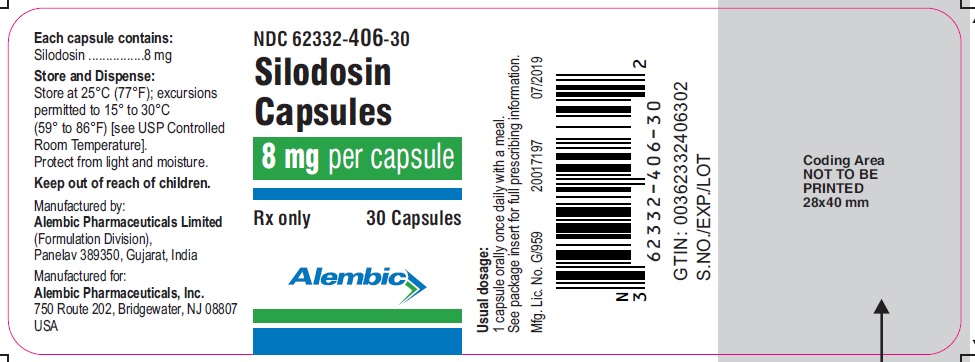
WARNINGS AND PRECAUTIONS SECTION
5 WARNINGS AND PRECAUTIONS
5.1 Orthostatic Effects
Postural hypotension, with or without symptoms (e.g., dizziness) may develop when beginning silodosin capsules treatment. As with other alpha-blockers, there is potential for syncope. Patients should be cautioned about driving, operating machinery, or performing hazardous tasks when initiating therapy [see ADVERSE REACTIONS (6), USE IN SPECIFIC POPULATIONS (8.5), CLINICAL PHARMACOLOGY (12.2), and PATIENT COUNSELING INFORMATION (17)].
5.2 Renal Impairment
In a clinical pharmacology study, plasma concentrations (AUC and Cmax) of silodosin were approximately three times higher in subjects with moderate renal impairment compared with subjects with normal renal function, while half-lives of silodosin doubled in duration. The dose of silodosin capsules should be reduced to 4 mg in patients with moderate renal impairment. Exercise caution and monitor such patients for adverse events [see USE IN SPECIFIC POPULATIONS (8.6) and CLINICAL PHARMACOLOGY (12.3)].
Silodosin capsules are contraindicated in patients with severe renal impairment [see CONTRAINDICATIONS (4)].
5.3 Hepatic Impairment
Silodosin capsule has not been tested in patients with severe hepatic impairment, and therefore, should not be prescribed to such patients [see CONTRAINDICATIONS (4), USE IN SPECIFIC POPULATIONS (8.7) and CLINICAL PHARMACOLOGY (12.3)].
5.4 Pharmacokinetic Drug-Drug Interactions
In a drug interaction study, co-administration of a single 8 mg dose of silodosin capsules with 400 mg ketoconazole, a strong CYP3A4 inhibitor, caused a 3.8-fold increase in maximum plasma silodosin concentrations and 3.2-fold increase in silodosin exposure (i.e., AUC). Concomitant use of ketoconazole or other strong CYP3A4 inhibitors (e.g., itraconazole, clarithromycin, ritonavir) is therefore contraindicated [see DRUG INTERACTIONS (7.1)].
5.5 Pharmacodynamic Drug-Drug Interactions
The pharmacodynamic interactions between silodosin and other alpha-blockers have not been determined. However, interactions may be expected, and silodosin capsules should not be used in combination with other alpha-blockers [see DRUG INTERACTIONS (7.3)].
A specific pharmacodynamic interaction study between silodosin and antihypertensive agents has not been performed. However, patients in the Phase 3 clinical studies taking concomitant antihypertensive medications with silodosin capsules did not experience a significant increase in the incidence of syncope, dizziness, or orthostasis. Nevertheless, exercise caution during concomitant use with antihypertensives and monitor patients for possible adverse events [see ADVERSE REACTIONS (6.1) and DRUG INTERACTIONS (7.6)].
Caution is also advised when alpha-adrenergic blocking agents including silodosin capsules are co-administered with PDE5 inhibitors. Alpha-adrenergic blockers and PDE5 inhibitors are both vasodilators that can lower blood pressure. Concomitant use of these two drug classes can potentially cause symptomatic hypotension [see DRUG INTERACTIONS (7.5)].
5.6 Carcinoma of the Prostate
Carcinoma of the prostate and BPH cause many of the same symptoms. These two diseases frequently co-exist. Therefore, patients thought to have BPH should be examined prior to starting therapy with silodosin capsules to rule out the presence of carcinoma of the prostate.
5.7 Intraoperative Floppy Iris Syndrome
Intraoperative Floppy Iris Syndrome has been observed during cataract surgery in some patients on alpha-1 blockers or previously treated with alpha-1 blockers. This variant of small pupil syndrome is characterized by the combination of a flaccid iris that billows in response to intraoperative irrigation currents; progressive intraoperative miosis despite preoperative dilation with standard mydriatic drugs; and potential prolapse of the iris toward the phacoemulsification incisions. Patients planning cataract surgery should be told to inform their ophthalmologist that they are taking silodosin capsules [see ADVERSE REACTIONS (6.1)].
5.8 Laboratory Test Interactions
No laboratory test interactions were observed during clinical evaluations. Treatment with silodosin capsules for up to 52 weeks had no significant effect on prostate-specific antigen (PSA).
- Postural hypotension, with or without symptoms (e.g., dizziness), may develop when beginning silodosin capsules treatment. (5.1)
- In patients with moderate renal impairment, silodosin capsules dose should be reduced to 4 mg once daily. (5.2)
- Silodosin capsules should not be used in combination with other alpha-blockers. (5.5)
- Examine patients thought to have BPH prior to starting therapy with silodosin capsules to rule out the presence of carcinoma of the prostate. (5.6)
- Inform patients planning cataract surgery to notify their ophthalmologist that they are taking silodosin capsules because of the possibility of Intraoperative Floppy Iris Syndrome (IFIS). (5.7)
DESCRIPTION SECTION
11 DESCRIPTION
Silodosin is a selective antagonist of alpha-1 adrenoreceptors. The chemical
name of silodosin is
1-(3-Hydroxypropyl)-5-[(2R)-2-({2-[2-(2,2,2-trifluoroethoxy)phenoxy]ethyl}amino)propyl]-2,3-dihydro-1H-indole-7-carboxamide
and the molecular formula is C25H32F3N3O4 with a molecular weight of 495.53.
The structural formula of silodosin is:

Silodosin is a white to pale yellow powder that melts at approximately 105 to 109°C. It is freely soluble in acetic acid, freely soluble in alcohol and very slightly to practically soluble in water.
Each silodosin capsules 4 mg capsule for oral administration contains 4 mg silodosin, and the following inactive ingredients: pregelatinized starch, sucrose, sodium lauryl sulfate and magnesium stearate. The size #3 hard gelatin capsules contain gelatin and titanium dioxide. The capsules are printed with edible gold ink containing shellac, propylene glycol and iron oxide yellow.
Each silodosin capsules 8 mg capsule for oral administration contains 8 mg silodosin, and the following inactive ingredients: pregelatinized starch, sucrose, sodium lauryl sulfate and magnesium stearate. The size #1 hard gelatin capsules contain gelatin and titanium dioxide. The capsules are printed with edible green ink containing shellac, propylene glycol, iron oxide yellow FD&C Blue No. 1 Aluminum Lake.
CLINICAL PHARMACOLOGY SECTION
12 CLINICAL PHARMACOLOGY
12.1 Mechanism of Action
Silodosin is a selective antagonist of post-synaptic alpha-1 adrenoreceptors, which are located in the human prostate, bladder base, bladder neck, prostatic capsule, and prostatic urethra. Blockade of these alpha-1 adrenoreceptors can cause smooth muscle in these tissues to relax, resulting in an improvement in urine flow and a reduction in BPH symptoms.
An in vitro study examining binding affinity of silodosin to the three subtypes of the alpha-1 adrenoreceptors (alpha-1A, alpha-1B, and alpha-1D) was conducted. The results of the study demonstrated that silodosin binds with high affinity to the alpha-1A subtype.
12.2 Pharmacodynamics
Orthostatic Effects
A test for postural hypotension was conducted 2 to 6 hours after the first dose in the two 12-week, double-blind, placebo-controlled clinical studies. After the patient had been at rest in a supine position for 5 minutes, the patient was asked to stand. Blood pressure and heart rate were assessed at 1 minute and 3 minutes after standing. A positive result was defined as a >30 mmHg decrease in systolic blood pressure, or a >20 mmHg decrease in diastolic blood pressure, or a >20 bpm increase in heart rate [see WARNINGS AND PRECAUTIONS (5.1)].
Table 2: Summary of Orthostatic Test Results in 12-week, Placebo-Controlled Clinical Trials
|
** Time of Measurement** |
Test Result |
Silodosin Capsules |
Placebo |
|
1 Minute After Standing |
Negative |
459 (98.7) 6 (1.3) |
454 (99.6) |
|
3 Minutes After |
Negative Positive |
456 (98.1) 9 (1.9) |
454 (99.6) 2 (0.4) |
Cardiac Electrophysiology
The effect of silodosin capsules on QT interval was evaluated in a double- blind, randomized, active-(moxifloxacin) and placebo-controlled, parallel- group study in 189 healthy male subjects aged 18 to 45 years. Subjects received either silodosin capsules 8 mg, silodosin capsules 24 mg, or placebo once daily for five days, or a single dose of moxifloxacin 400 mg on Day 5 only. The 24 mg dose of silodosin capsules was selected to achieve blood levels of silodosin that may be seen in a “worst-case” scenario exposure (i.e., in the setting of concomitant renal disease or use of strong CYP3A4 inhibitors) [see CONTRAINDICATIONS (4), WARNINGS AND PRECAUTIONS (5.3) and CLINICAL PHARMACOLOGY (12.3)]. QT interval was measured during a 24-hour period following dosing on Day 5 (at silodosin steady state).
Silodosin capsules was not associated with an increase in individual corrected (QTcI) QT interval at any time during steady state measurement, while moxifloxacin, the active control, was associated with a maximum 9.59 msec increase in QTcI.
There has been no signal of Torsade de Pointes in the post-marketing experience with silodosin outside the United States.
12.3 Pharmacokinetics
The pharmacokinetics of silodosin have been evaluated in adult male subjects
with doses ranging from 0.1 mg to 24 mg per day. The pharmacokinetics of
silodosin are linear throughout this dosage range.
Absorption
The pharmacokinetic characteristics of silodosin 8 mg once daily were determined in a multi-dose, open-label, 7-day pharmacokinetic study completed in 19 healthy, target-aged (≥ 45 years of age) male subjects. Table 3 presents the steady state pharmacokinetics of this study.
Table 3: Mean (±SD) Steady State Pharmacokinetic Parameters in Healthy Males Following Silodosin 8 mg Once Daily with Food
|
Cmax |
tmax |
t1/2 |
AUCss |
|
61.6 ± 27.54 |
2.6 ± 0.9 |
13.3 ± 8.07 |
373.4 ± 164.94 |
Cmax = maximum concentration, tmax = time to reach Cmax, t1/2 = elimination
half-life, AUCss = steady state area under the concentration-time curve
Figure 1: Mean (±SD) Silodosin Steady State Plasma Concentration-Time
Profile in Healthy Target-Aged Subjects Following Silodosin 8 mg Once Daily
with Food
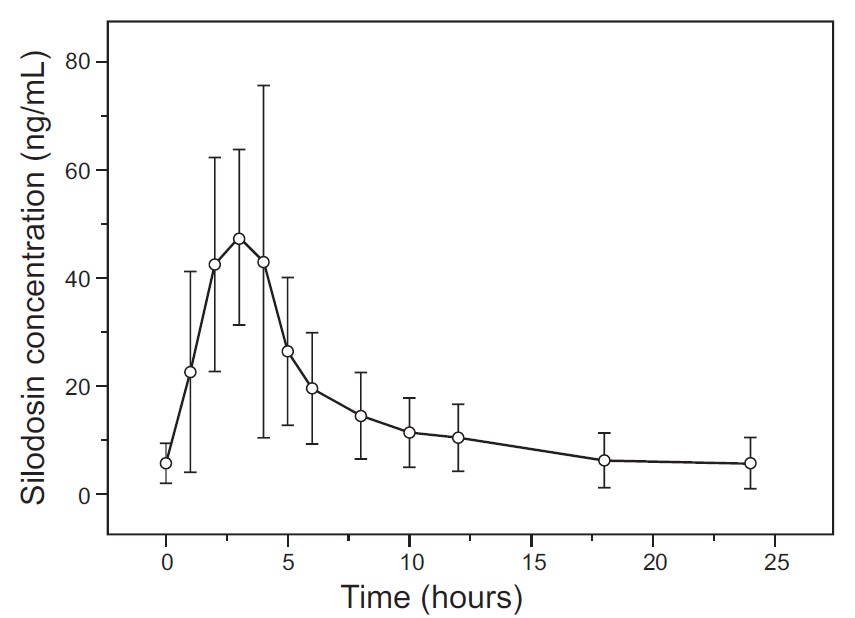
The absolute bioavailability is approximately 32%.
Food Effect
The maximum effect of food (i.e., co-administration with a high fat, high
calorie meal) on the PK of silodosin was not evaluated. The effect of a
moderate fat, moderate calorie meal was variable and decreased silodosin Cmax
by approximately 18 to 43% and AUC by 4 to 49% across three different studies.
In a single-center, open-label, single-dose, randomized, two-period crossover study in twenty healthy male subjects age 21 to 43 years under fed conditions, a study was conducted to evaluate the relative bioavailability of the contents of an 8 mg capsule (size #1) of silodosin sprinkled on applesauce compared to the product administered as an intact capsule. Based on AUC0-24 and Cmax, silodosin administered by sprinkling the contents of a silodosin capsules capsule onto a tablespoonful of applesauce was found to be bioequivalent to administering the capsule whole.
Distribution
Silodosin has an apparent volume of distribution of 49.5 L and is approximately 97% protein bound.
Elimination
Metabolism
Silodosin undergoes extensive metabolism through glucuronidation, alcohol and aldehyde dehydrogenase, and cytochrome P450 3A4 (CYP3A4) pathways. The main metabolite of silodosin is a glucuronide conjugate (KMD-3213G) that is formed via direct conjugation of silodosin by UDP-glucuronosyltransferase 2B7 (UGT2B7). Co-administration with inhibitors of UGT2B7 (e.g., probenecid, valproic acid, fluconazole) may potentially increase exposure to silodosin. KMD-3213G, which has been shown in vitro to be active, has an extended half- life (approximately 24 hours) and reaches plasma exposure (AUC) approximately four times greater than that of silodosin. The second major metabolite (KMD-3293) is formed via alcohol and aldehyde dehydrogenases and reaches plasma exposures similar to that of silodosin. KMD-3293 is not expected to contribute significantly to the overall pharmacologic activity of silodosin capsules.
Excretion
Following oral administration of 14C-labeled silodosin, the recovery of radioactivity after 10 days was approximately 33.5% in urine and 54.9% in feces. After intravenous administration, the plasma clearance of silodosin was approximately 10 L/hour.
Special Populations
Race
No clinical studies specifically investigating the effects of race have been performed.
Geriatric
In a study comparing 12 geriatric males (mean age 69 years) and 9 young males (mean age 24 years), the exposure (AUC) and elimination half-life of silodosin were approximately 15% and 20%, respectively, greater in geriatric than young subjects. No difference in the Cmax of silodosin was observed [see USE IN SPECIFIC POPULATIONS (8.5)].
Pediatric
Silodosin capsule has not been evaluated in patients less than 18 years of age.
Renal Impairment
In a study with six subjects with moderate renal impairment, the total
silodosin (bound and unbound) AUC, Cmax, and elimination half-life were 3.2-,
3.1-, and 2-fold higher, respectively, compared to seven subjects with normal
renal function. The unbound silodosin AUC and Cmax were 2- and 1.5-fold
higher, respectively, in subjects with moderate renal impairment compared to
the normal controls.
In controlled and uncontrolled clinical studies, the incidence of orthostatic
hypotension and dizziness was greater in subjects with moderate renal
impairment treated with 8 mg silodosin capsules daily than in subjects with
normal or mildly impaired renal function [see CONTRAINDICATIONS (4), WARNINGS AND PRECAUTIONS (5.2) and USE IN SPECIFIC POPULATIONS (8.6)].
Hepatic Impairment
In a study comparing nine male patients with moderate hepatic impairment (Child-Pugh scores 7 to 9), to nine healthy male subjects, the single dose pharmacokinetic disposition of silodosin was not significantly altered in the patients with moderate hepatic impairment. No dosing adjustment is required in patients with mild or moderate hepatic impairment. The pharmacokinetics of silodosin in patients with severe hepatic impairment have not been studied [see CONTRAINDICATIONS (4), WARNINGS AND PRECAUTIONS (5.3) and USE IN SPECIFIC POPULATIONS (8.7)].
Drug Interactions
Cytochrome P450 (CYP) 3A4 Inhibitors
Two clinical drug interaction studies were conducted in which a single oral
dose of silodosin was co-administered with the strong CYP3A4 inhibitor,
ketoconazole, at doses of 400 mg and 200 mg, respectively, once daily for 4
days. Co-administration of 8 mg silodosin with 400 mg ketoconazole led to
3.8-fold increase in silodosin Cmax and 3.2-fold increase in AUC. Co-
administration of 4 mg silodosin with 200 mg ketoconazole led to similar
increases: 3.7- and 2.9-fold in silodosin Cmax and AUC, respectively.
Silodosin is contraindicated with strong CYP3A4 inhibitors.
The effect of moderate CYP3A4 inhibitors on the pharmacokinetics of silodosin
has not been evaluated. Due to the potential for increased exposure to
silodosin, caution should be exercised when co-administering silodosin with
moderate CYP3A4 inhibitors, particularly those that also inhibit
P-glycoprotein (e.g., verapamil, erythromycin).
P-glycoprotein (P-gp) Inhibitors
In vitro studies indicated that silodosin is a P-gp substrate. A drug interaction study with a strong P-gp inhibitor has not been conducted. However, in drug interaction studies with ketoconazole, a CYP3A4 inhibitor that also inhibits P-gp, significant increase in exposure to silodosin was observed [see CLINICAL PHARMACOLOGY (12.3)]. Inhibition of P-gp may lead to increased silodosin concentration. Silodosin is not recommended in patients taking strong P-gp inhibitors (e.g., cyclosporine).
Digoxin
The effect of silodosin on the pharmacokinetics of digoxin was evaluated in a multiple dose, single-sequence, crossover study of 16 healthy males, aged 18 to 45 years. A loading dose of digoxin was administered as 0.5 mg twice daily for one day. Following the loading doses, digoxin (0.25 mg once daily) was administered alone for seven days and then concomitantly with silodosin 4 mg twice a day for the next seven days. No significant differences in digoxin AUC and Cmax were observed when digoxin was administered alone or concomitantly with silodosin.
Other Metabolic Enzymes and Transporters
In vitro studies indicated that silodosin administration is not likely to
inhibit the activity of CYP1A2, CYP2A6, CYP2C9, CYP2C19, CYP2D6, CYP2E1, and
CYP3A4 or induce the activity of CYP1A2, CYP2C8, CYP2C9, CYP2C19, CYP3A4, and
P-gp.
CLINICAL STUDIES SECTION
14 CLINICAL STUDIES
14.1 Benign Prostatic Hyperplasia
Two 12-week, randomized, double-blind, placebo-controlled, multicenter studies were conducted with 8 mg daily of silodosin. In these two studies, 923 patients [mean age 64.6 years; Caucasian (89.3%), Hispanic (4.9%), Black (3.9%), Asian (1.2%), Other (0.8%)] were randomized and 466 patients received silodosin capsules 8 mg daily. The two studies were identical in design except for the inclusion of pharmacokinetic sampling in Study 1. The primary efficacy assessment was the International Prostate Symptom Score (IPSS) which evaluated irritative (frequency, urgency, and nocturia), and obstructive (hesitancy, incomplete emptying, intermittency, and weak stream) symptoms. Maximum urine flow rate (Qmax) was a secondary efficacy measure.
Mean changes from baseline to last assessment (Week 12) in total IPSS score were statistically significantly greater for groups treated with silodosin capsules than those treated with placebo in both studies (Table 4 and Figures 2 and 3).
Table 4: Mean Change (SD) from Baseline to Week 12 in International Prostate Symptom Score in Two Randomized, Controlled, Double-Blind Studies
|
Total Symptom Score |
Study 1 |
Study 2 | ||||
|
Silodosin Capsules |
Placebo |
p-value |
Silodosin Capsules |
Placebo |
p-value | |
|
Baseline |
21.5 (5.38) |
21.4 (4.91) |
21.2 (4.88) |
21.2 (4.92) | ||
|
Week 12 / LOCF Change from Baseline |
-6.5 (6.73) |
-3.6 (5.85) |
< 0.0001 |
-6.3 (6.54) |
-3.4 (5.83) |
< 0.0001 |
LOCF – Last observation carried forward for those not completing 12 weeks of treatment.
Figure 2: Mean Change from Baseline in IPSS Total Score by Treatment Group
and Visit in Study 1
****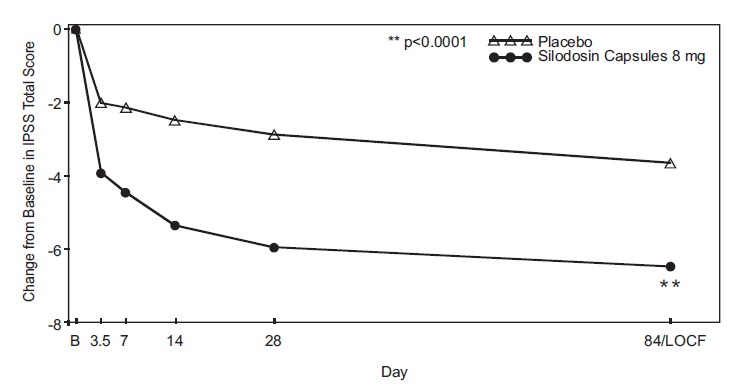
B – Baseline determination taken Day 1 of the study before the initial dose.
Subsequent values are observed cases except for LOCF values.
LOCF – Last observation carried forward for those not completing 12 weeks of
treatment.
Figure 3: Mean Change from Baseline in IPSS Total Score by Treatment Group and Visit in Study 2
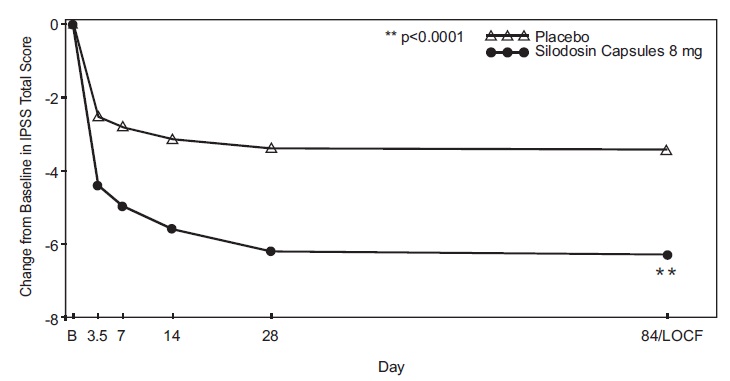
B – Baseline determination taken Day 1 of the study before the initial dose.
Subsequent values are observed cases except for LOCF values.
LOCF – Last observation carried forward for those not completing 12 weeks of
treatment.
Mean IPSS total score for silodosin capsules once daily groups showed a decrease starting at the first scheduled observation and remained decreased through the 12 weeks of treatment in both studies.
Silodosin capsules produced statistically significant increases in maximum urinary flow rates from baseline to last assessment (Week 12) versus placebo in both studies (Table 5 and Figures 4 and 5). Mean peak flow rate increased starting at the first scheduled observation at Day 1 and remained greater than the baseline flow rate through the 12 weeks of treatment for both studies.
Table 5: Mean Change (SD) from Baseline in Maximum Urinary Flow Rate (mL/sec) in Two Randomized, Controlled, Double-Blind Studies
|
**Mean Maximum Flow |
** Study 1** |
Study 2 | ||||
|
Silodosin Capsules |
**Placebo |
** p-value** |
**Silodosin Capsules |
Placebo |
p-value | |
|
****Baseline |
9 (2.6) |
****9 (2.85) |
|
****8.4 (2.48) |
****8.7 (2.67) |
|
|
****Week 12 / LOCF Change from Baseline |
****2.2 (4.31) |
1.2 (3.81) |
0.006 |
2.9 (4.53) |
1.9 (4.82) |
0.0431 |
LOCF – Last observation carried forward for those not completing 12 weeks of treatment.
Figure 4: Mean Change from Baseline in Qmax (mL/sec) by Treatment
Group and Visit in Study 1
****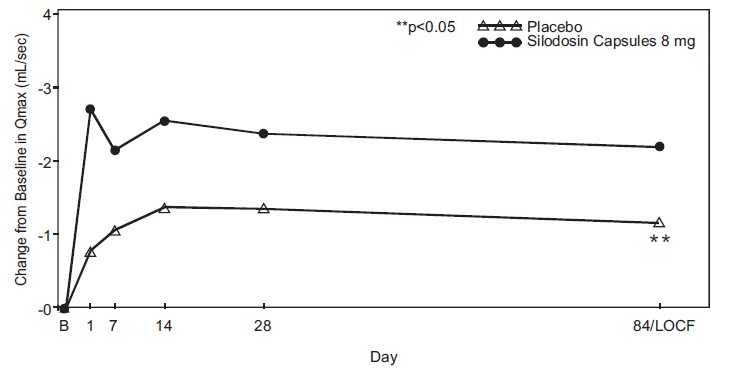
B – Baseline determination taken Day 1 of the study before the initial dose.
Subsequent values are observed cases except for LOCF values.
LOCF – Last observation carried forward for those not completing 12 weeks of
treatment.
Note – The first Qmax assessments at Day 1 were taken 2 to 6 hours after
patients received the first dose of double-blind medication.
Note – Measurements at each visit were scheduled 2 to 6 hours after dosing
(approximate peak plasma silodosin concentration).
Figure 5: Mean Change from Baseline in Qmax (mL/sec) by Treatment
Group and Visit in Study 2
****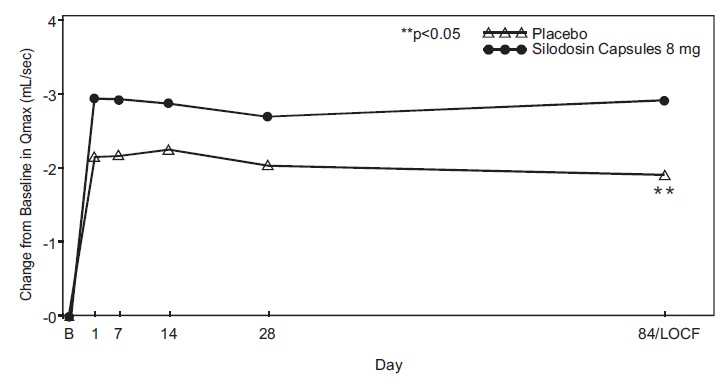
B – Baseline determination taken Day 1 of the study before the initial dose.
Subsequent values are observed cases except for LOCF values.
LOCF – Last observation carried forward for those not completing 12 weeks of
treatment.
Note – The first Qmax assessments at Day 1 were taken 2 to 6 hours after
patients received the first dose of double-blind medication.
Note – Measurements at each visit were scheduled 2 to 6 hours after dosing
(approximate peak plasma silodosin concentration).
